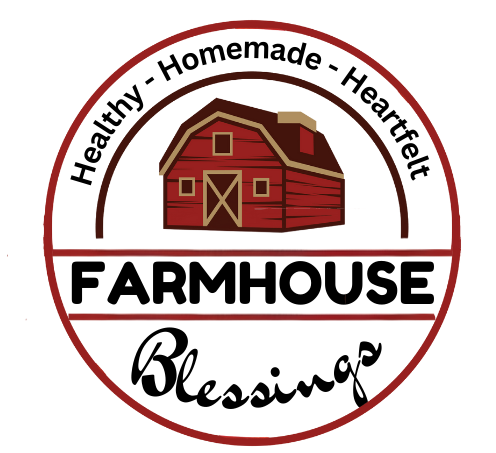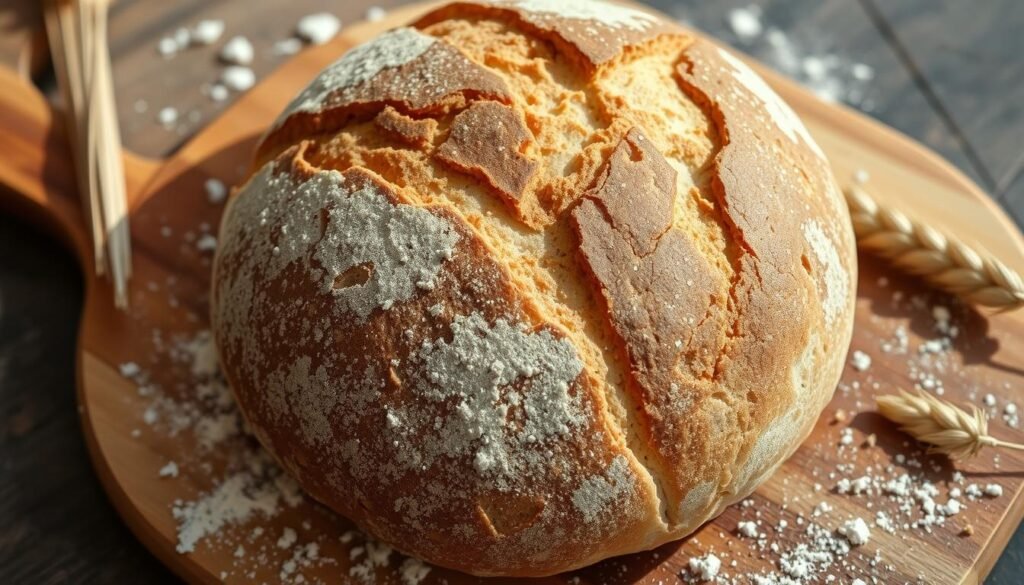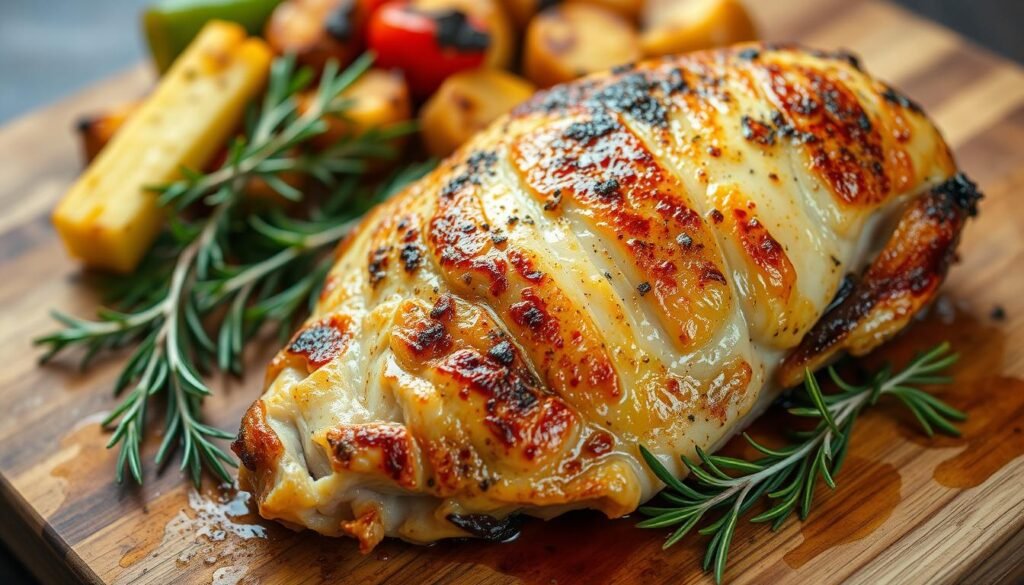Ever wondered why some sourdough loaves are so good while others are not? As a home baker, I’m excited to share my knowledge. We’ll explore how to make the perfect sourdough, from starting a sourdough starter to understanding fermentation.
Want to make artisanal sourdough at home? Get ready to be amazed. We’ll look into sourdough’s history, its cultural value, and what you need to make it.
Key Takeaways
- Discover the ancient history and cultural significance of sourdough bread
- Learn how to cultivate and maintain a thriving sourdough starter
- Understand the science behind fermentation and its role in achieving the perfect crumb and crust
- Master essential techniques for shaping, scoring, and baking exceptional sourdough loaves
- Troubleshoot common issues and learn advanced tips for consistent, bakery-quality results
The Ancient Art and History of Sourdough Bread Making
The art of sourdough bread making dates back to ancient Egypt. It was a staple in their bakery and food culture. Over time, the craft of bread making has grown, but sourdough’s essence remains unchanged. It shows the lasting traditions that have shaped our world.
From Ancient Egypt to Modern Artisanal Baking
Sourdough bread is known for its tangy flavor and chewy texture. It has fascinated bakers and fans for centuries. The Egyptians first used wild yeasts to make this bread, which was both healthy and tasty.
This ancient method has traveled the world. It has inspired many to keep the art of sourdough bread making alive.
How Sourdough Shaped Human Civilization
- Sourdough bread was key in ancient times. It was a reliable food source and helped start culinary traditions.
- Learning to make sourdough helped preserve grains. This led to better farming and society growth.
- Sourdough’s cultural importance is seen in its role in religious and social events. It has shaped food cultures worldwide.
The Renaissance of Traditional Bread Making
In recent years, sourdough bread has seen a comeback. Artisanal bakers and fans have rediscovered traditional methods. This revival has not only boosted the bakery industry but also deepened our appreciation for this ancient craft.
| Sourdough Bread in History | Modern Artisanal Baking |
|---|---|
|
|
Understanding Wild Yeast and Natural Fermentation
As a passionate home baker, I’ve learned a lot about wild yeast and natural fermentation. These elements are key in making sourdough bread special. They add unique flavors, textures, and health benefits.
Wild yeast, found in our environment, is crucial in fermentation. Unlike commercial yeast, it’s a mix of microorganisms. Together, they turn flour, water, and time into a delicious bread.
The levain method lets wild yeast thrive, creating sourdough’s unique taste. As yeast eats flour’s sugars, it makes the bread airy and chewy. The acids it produces also make the bread tangy and easier to digest.
Using wild yeast and natural fermentation has changed my baking. I love the complex flavors and the healthier bread it makes. It shows the value of traditional methods that have lasted for centuries.
Essential Tools and Ingredients for Sourdough Success
As a bread baker, I’ve learned that the right tools and ingredients are key. I’ll show you the must-have tools and the best flour, water, and salt for baking.
Must-Have Equipment for Your Sourdough Journey
For making artisan bread at home, you need a few essential tools. These tools will make your baking easier and more consistent. Here are the key items you should have:
- A sturdy mixing bowl or stand mixer for kneading and mixing the dough
- A digital kitchen scale to precisely measure ingredients
- A dough scraper or bench scraper for shaping and handling the dough
- A proofing basket or banneton to shape and proof the dough
- A Dutch oven or baking stone for achieving the perfect crust and oven spring
- A bread lame or razor blade for scoring the dough before baking
Quality Ingredients That Make a Difference
The quality of your ingredients is crucial in bread baking. Use high-quality, freshly milled flour for the best flavor and texture. Freshly milled flour from a local or artisanal source is ideal.
Also, use filtered water and premium salt like Himalayan or sea salt. These will improve the taste and performance of your sourdough.
Setting Up Your Bread Making Station
Having a dedicated workspace is important for a smooth bread-making process. Choose a clean, clutter-free area for mixing, kneading, and shaping. Make sure it has a sturdy work surface, organized storage, and good lighting.
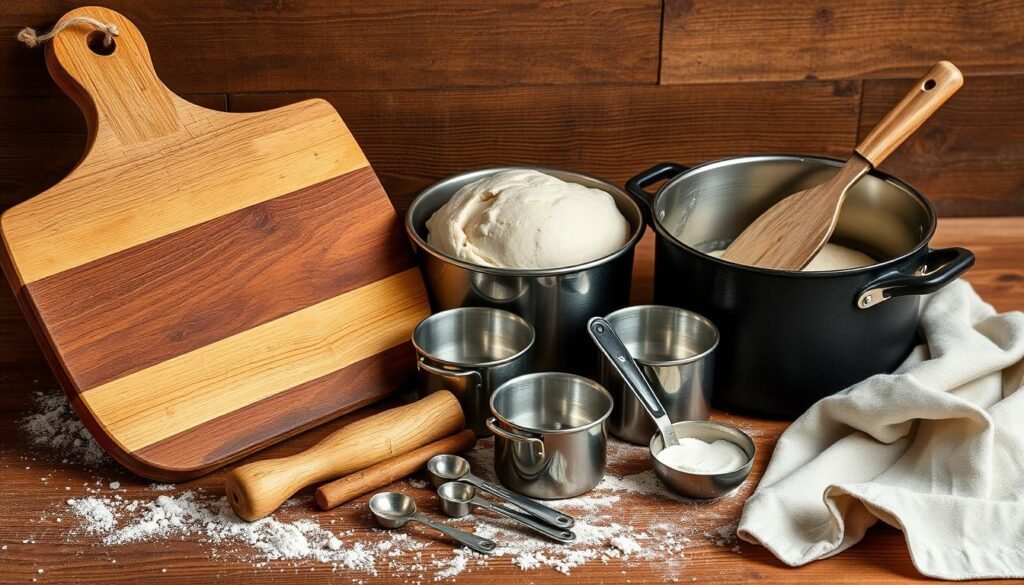
Investing in the right equipment and quality ingredients will help you master sourdough bread baking. With a well-equipped workspace, you can focus on fermentation and dough development. This will help you create loaves that deserve the artisan bread label.
Creating and Maintaining Your Sourdough Starter
Creating a healthy sourdough starter is key to baking great bread. It’s all about using wild yeast and caring for it through fermentation. As a home baker, I’ve found that with the right steps, you can keep a bread starter for years.
To start, you need simple ingredients and patience. Feed your starter often to keep it full of active yeast and bacteria. This will make your bread tangy and chewy.
- Start by mixing equal parts flour and water in a clean jar. Whole wheat or rye flour is best for a strong starter.
- Cover it loosely and let it sit at room temperature for 24 hours. This lets the wild yeast in the air start fermentation.
- After 24 hours, throw away half of the starter. Add more flour and water, keeping the 1:1 ratio. Do this every 12-24 hours to keep it bubbly.
- As days pass, your starter will get more active. You’ll see bubbles and it will grow. This means fermentation is working, and your starter is ready to use.
Keeping your sourdough starter alive is a daily task. But with a bit of care, it will be your bread-baking friend. Feed it often, keep it cool and dark, and discard some before each feeding to keep it healthy.
| Starter Feeding Schedule | Discard Amount | Feed Ratio |
|---|---|---|
| Every 12-24 hours | About half | 1:1 (flour:water) |
With a good sourdough starter, you can make endless delicious breads. Start your journey with wild yeast and discover the true taste of bread making.
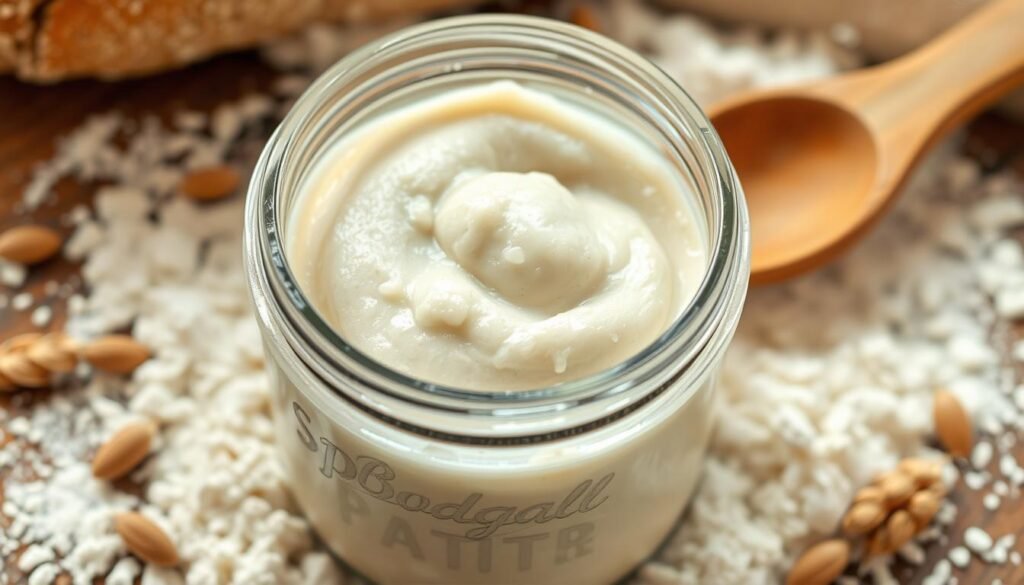
“Sourdough is a living thing, and it’s up to you to nurture it. With a little care and attention, your starter will reward you with the most amazing bread.”
The Science Behind Perfect Sourdough Fermentation
I love bread making, especially sourdough. It’s all about the science behind the fermentation. This process creates the flavors and textures we all love in sourdough. Let’s explore how to improve your bread making skills.
Understanding Temperature and Time
Temperature and time are key for sourdough. The best temperature is between 70-85°F. This helps the good bacteria and yeasts grow, making the dough balanced and perfect.
Changing the fermentation time lets you adjust the flavor and sourness. You can choose from 8 to 24 hours. This way, you can make your sourdough just right for you.
The Role of Hydration Levels
Hydration is crucial for the dough’s texture and rise. The water in your dough affects the gluten and the bread’s structure. Try different water amounts, from 60% to 80%, to find the perfect crumb and crust.
Mastering pH Levels and Bacterial Growth
The pH level shows how well your sourdough is fermenting. As bacteria break down sugars, the pH drops, making it sour. Knowing how to adjust the pH, between 4.0 and 4.5, helps balance the flavors.
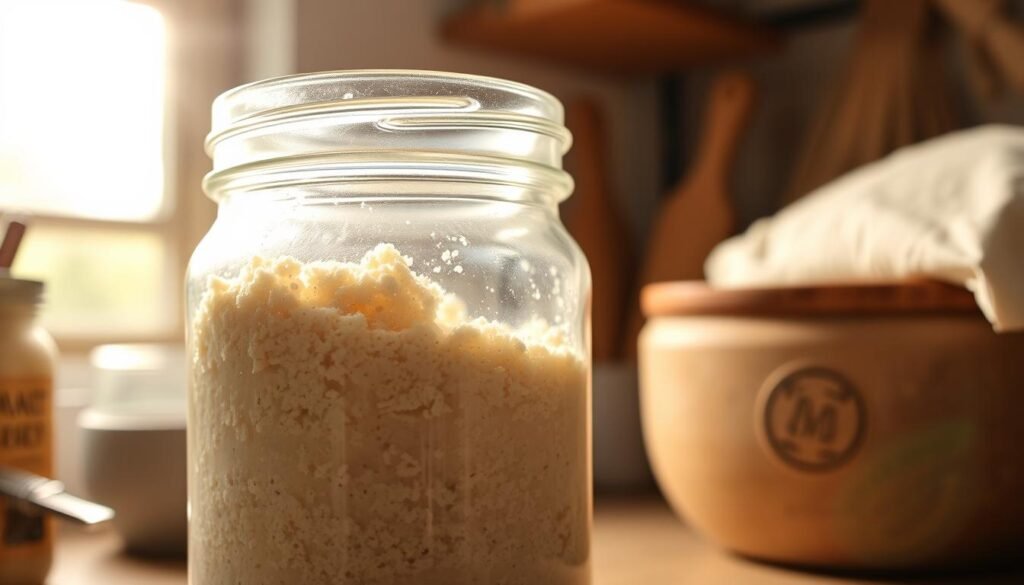
Learning about temperature, hydration, and pH is key to making great sourdough. With this knowledge, you can fine-tune your baking. Enjoy making your perfect sourdough bread!
Mastering the Art of Sourdough Dough Development
I’ve spent hours perfecting sourdough dough development. I’ve learned about kneading and fermentation. Now, I can make artisan bread at home.
Creating a great sourdough dough is key to making amazing bread. Kneading is crucial. It can be done by hand or with a stand mixer. The right amount of time and effort changes the dough’s texture and rise.
- Gentle Kneading: Start with a light touch, gently folding and pressing the dough to develop the gluten structure without overworking it.
- Timed Kneading: Gradually increase the kneading time, allowing the dough to develop the optimal elasticity and strength.
- Autolyse Method: Incorporating an autolyse (resting period) before kneading can significantly improve dough development and rise.
The bulk fermentation stage is also important. It’s about finding the right balance of flavor and rise. Folding the dough helps build structure and creates air pockets.
“The key to exceptional sourdough is understanding the science behind dough development and using that knowledge to guide your hands-on approach.”
Getting good at sourdough takes time and patience. But the results are worth it. With the right techniques, you can make artisan bread that impresses everyone.
Advanced Shaping and Scoring Techniques
Take your bread making to the next level with advanced techniques. Learn to create stunning loaves that impress everyone. Discover the secrets of bread patterns, dough tension, and special scoring tools.
Creating Beautiful Bread Patterns
Let your creativity shine with amazing bread patterns. Try the “slash,” “quilt,” or “herringbone” designs. With practice, your loaves will become true masterpieces.
Understanding Dough Tension
Mastering dough tension is key for perfect loaves. Learn to shape and stretch your dough right. Use “coil folding” and “tension shaping” for loaves that keep their shape.
Tools and Methods for Artistic Scoring
- Lame or Bread Scoring Knife: A sharp, angled blade for precise cuts.
- Scoring Wheel: Creates intricate patterns with a gentle roll.
- Razor Blades: Simple for clean, straight scores.
- Scoring Patterns: Try “hashtag,” “cross,” or “leaf” for visual appeal.
Embrace the art of scoring to make your sourdough stand out. With the right tools and techniques, your loaves will impress anyone.
Baking Methods and Troubleshooting Common Issues
As a passionate bread baker, I’ve learned that making great sourdough is more than just mixing dough. It’s about mastering different baking methods. I’ll share tips on getting the perfect crust, managing oven spring, and adjusting baking times and temperatures. This will help you succeed in making artisan bread.
Choosing the right baking method is crucial for delicious sourdough bread. I’ll cover traditional oven baking and new techniques like steam injections and Dutch oven baking. You’ll learn the pros and cons of each, helping you pick the best one for you. This way, you’ll always get the bread baking results you want.
Every sourdough baker faces common problems. I’ll help you solve issues like managing oven spring and getting the perfect crust. You’ll also learn how to tackle other challenges. With my advice, you’ll become a skilled sourdough baker, ready to handle any problem that comes your way.
